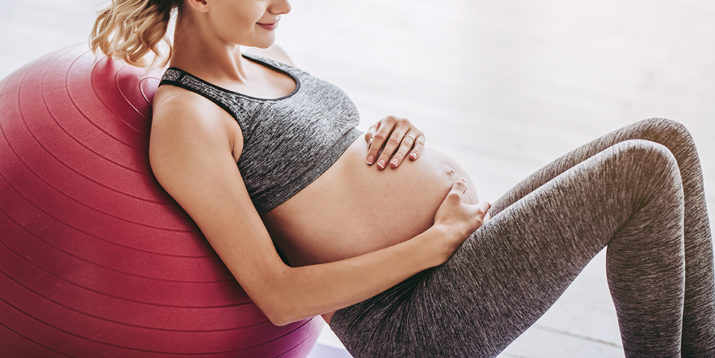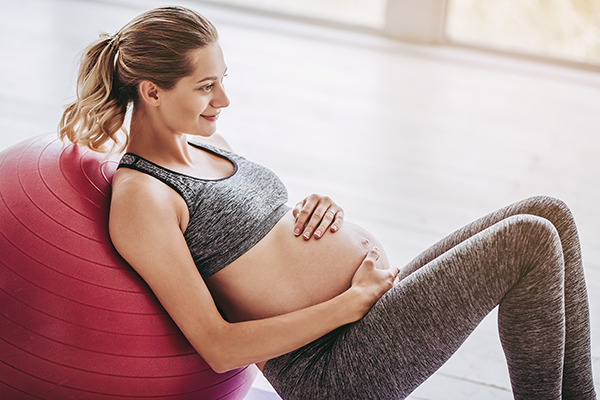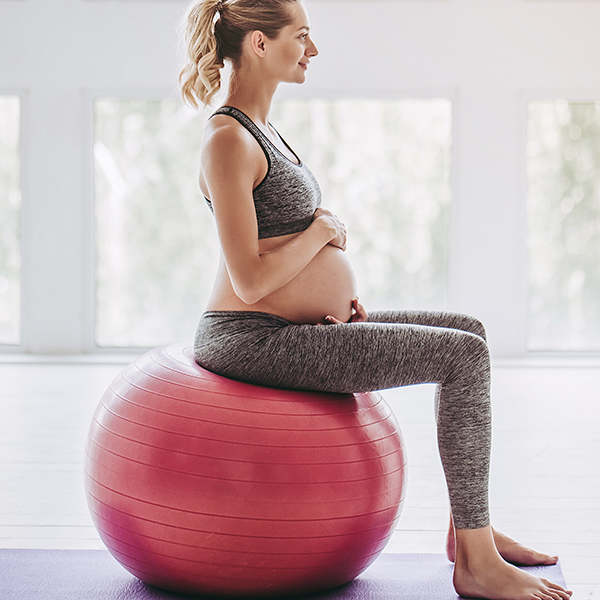9 Pregnancy Ball Exercises for Expecting Moms

Busy growing a new life? Don’t worry, you can still stay active! Pregnancy ball exercises can help engage your core and improve hip stability.
Moms-to-be have lots of options to choose from.
Love yoga? Try prenatal yoga designed to work with your growing belly. Hooked on barre? Try a Pre & Post Natal Barre Blend class.
Whether you call it an exercise ball, stability ball, Swiss ball, balance ball, or birthing ball, there are plenty of pregnancy ball exercises you can do at home with this simple and inexpensive piece of equipment.
Fun fact: You may even be able to use that same exercise ball as a birthing ball in the delivery room!
Is it Safe to Use an Exercise Ball During Pregnancy?
Short answer: In general, exercise balls can safely be used during pregnancy. Before you start any exercise plan while pregnant, it’s important to check with your doctor.
And keep in mind your workouts may change over the course of your pregnancy due to morning sickness, energy levels, or just general discomfort.
“A large exercise ball can be used safely in pregnancy for some — mostly seated — exercises,” says Daniel Roshan, MD, FACOG, FACS, a high-risk, maternal-fetal OB/GYN in New York City. “In pregnancy, we advise against strenuous abdominal exercises and encourage patients to modify their exercise routines as needed as their body changes throughout pregnancy.”
An exercise ball can challenge your balance, but when you’re pregnant, Roshan recommends making sure you’re stable during any pregnancy ball exercises.
“We do not advise patients to do any exercises with the exercise ball in which they are not seated with both feet on the floor, or anything that makes them unsteady, increasing their risk of falling,” he says.
And according to the American College of Obstetricians and Gynecologists, you’ll want to avoid exercises that have you lying on your back, as this can cause a drop in blood pressure.

9 Pregnancy Ball Exercises to Try
“During pregnancy, you still want to make sure you’re strengthening your core,” says Liz Smith, a certified personal trainer and founder of RebelMom, which provides nutrition and fitness coaching for moms and moms-to-be.
Using an exercise ball may help to alleviate pressure on the lower back and pelvis while you work out.
Ready to give it a try? If your doctor has given you the green light to work out during your pregnancy, here are 9 exercises to start with.
1. Wall squat
- Place an exercise ball between your lower back and a solid wall or steady surface.
- Stand with your feet slightly wider than hip-width apart and bend your knees to slowly lower yourself into a squatting position, using the ball as support.
- Push back up to a standing position and repeat.
2. Ab crunch
While lying on your back for standard crunches isn’t advised, Smith recommends this modification instead.
- Sit upright on an exercise ball and walk your feet forward so they are just in front of your knees.
- Continue taking small steps until your lower back touches the ball. Your feet should remain flat on the ground with knees bent, and your body should be at an incline with hips lower than your shoulders.
- Bring your hands behind your head, contract your abs in toward your spine, and lift your head, arms, and shoulders up and forward.
Make sure the ball is on a non-slip surface, or against the wall, to keep it from slipping out from under you — and stop if you feel any discomfort.
3. Pelvic floor exercises
- Sit on the ball with a straight spine.
- Contract your pelvic muscles, as you would to stop the flow of urine. Hold for a few seconds.
- Release and repeat.
“Be sure not to hold your breath!” Smith says.
4. Ball march
- Sit on the ball with your feet firmly planted on the floor.
- Exhale and draw your belly button towards your spine as you slowly lift one knee without letting the ball or your hips move.
- Slowly place your foot back down and repeat on the other side. Keep alternating sides for 10 repetitions. (Don’t forget to breathe!)
“If this is too hard, you can just lift up your heel and keep your toes on the ground,” says Stephanie Stamas, DPT, a pelvic health specialist and co-founder of Chelsea Method, an online pregnancy and postpartum rehab program.
5. Ball bridges
“Labor requires a lot of hip and gluteal strength, so training these muscles is important!” Stamas says. (This move may be too challenging or uncomfortable later in pregnancy, she advises.)
- Start by sitting on the floor with your upper back against the ball.
- Push up through both of your feet and lift your hips off the floor towards the ceiling, as high as you can comfortably go without arching your back.
- Hold for three seconds and slowly lower back down. Repeat 10 times.
6. Kneeling ball roll-outs
- Start in a high kneeling position with your hands on the ball.
- Keeping your back straight, roll the ball forward until you can feel your core engaging.
- Hold for three seconds, then roll the ball back in. “Only go out as far as your abdominal muscles can stabilize without bulging,” Stamas says.
- Repeat 10 times, and make sure you continue to breathe throughout the exercise.
7. Back and upper-body stretch
“The chest and abdomen often get really tight during pregnancy, so this can be a great stretch!” Stamas says.
- Kneel on the floor, hinge forward at your hips, and rest your arms on the ball.
- Gently rock the ball to one side until you feel a stretch. Hold here while breathing into the opposite side of your rib cage for 30 seconds.
- Repeat on the other side.
8. Ball circles
- Sit on the ball with your feet firmly planted on the floor, slightly wider than hip-width apart.
- Move your hips in a circular motion to “draw” small circles on the floor with the ball.
- Do 10 repetitions clockwise, then repeat counter-clockwise.
9. Figure-8
- Sit on the ball with your feet firmly planted on the floor, slightly wider than hip-width apart.
- Move your hips as if you’re drawing a figure eight on the ball.
This move is great for opening up your pelvis.

Is There a Difference Between an Exercise Ball and a Birthing Ball?
While exercise balls can be a healthy part of pregnancy-safe workouts, they also can serve as a birthing ball, too.
“The exercise ball is a wonderful tool that can help you go through the different stages of pregnancy — and labor! — in a calmer and relaxed way,” says Tal Siperman Cohen, an ACSM-certified personal trainer with an extended specialty in Prenatal And Postpartum Exercise Design by Human Kinetics USA.
During your pregnancy, sitting on an exercise ball may help to open up the pelvis and pelvic floor.
“This helps to create space for the baby to drop lower into the pelvis — a necessary step as you move towards birth,” Stamas explains. It may also help alleviate back pain, she says.
“Many patients use exercise balls during early labor to relieve some of the pressure associated with labor pains,” Roshan says.
Of course, be sure to ask your obstetrician and delivery center what their policies are when it comes to birthing balls.
Choosing the Right Exercise Ball
“When choosing an exercise ball, make sure you select the appropriate size based on your height,” Stamas says.
- 5’0″ and under: 45 cm width ball
- 5’1″ – 5’8″: 55 cm width ball
- 5’9 – 6’2′: 65 cm width ball
- 6’3″ and up: 75 cm width ball
Once the exercise ball is inflated, check your body position.
“When you sit on the ball, your hips should be slightly higher than your knees to avoid pressure on your back, to allow lots of space for your tummy, and to give you stability,” Cohen says.
If you’re between sizes, Cohen suggests choosing the smaller size — especially if you plan to use it as a birthing ball too.
“I personally recommend getting the smallest one that can suit your needs,” she says. “During labor itself, it’s relaxing to lean on the ball on all fours, and a big ball might not be comfortable.”
